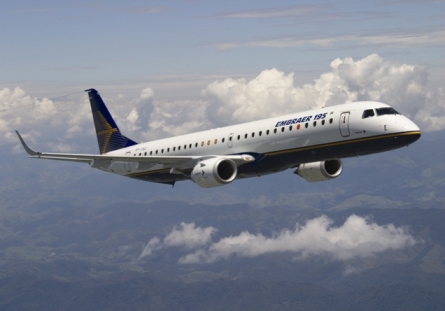Embraer is talking to General Electric, Rolls-Royce and Pratt & Whitney about new-generation engines to power a potential clean-sheet airliner design under study which is larger than the E-Jet family, a top Embraer official reveals.
In what is perhaps the Brazilian airframer's strongest indication yet that it may bring to market a clean-sheet competitor to Bombardier's P&W geared turbofan-powered CSeries, Embraer executive vice president airline market Mauro Kern says that Embraer is studying "some possible work with a little bigger [aircraft] than the current 195, not only in terms of using the current platform, but also in terms of actually a new design".
The four-abreast Embraer 195 in operation today is the airframer's largest commercial aircraft and can seat about 120 passengers at its highest density. Bombardier's five-abreast CSeries is targeted for the 110/130-seat market, and can seat up to 145 passengers. It is expected to enter into service in late 2013.
If Embraer opts to develop a next-generation aircraft based on a clean-sheet design, it would need "a new-generation engine", says Kern. To that end, Embraer has been "in talks with the three big engine guys [GE, Rolls-Royce and P&W] about a possible new platform to support new airplanes".
He adds: "GE is a very close partner of ours [as] they are working with us on the E-Jets, and we are talking with GE basically besides Pratt and Rolls right now."
However, while P&W "started this race with the geared turbofan, and GE and Rolls are very seriously looking at new technology for a new generation engine", Embraer does not see "enough maturity to make a decision at this point", says Kern, adding: "Maybe in 18 to 24 months we'll have a better, more clearer view about that."
Industry sources say that the thrust requirement for the size of aircraft being considered by Embraer is likely to be beyond the nominal 20,000lb (89kN) upper threshold agreed by CFM International partners GE and Snecma for unilateral engine development, meaning that the any offering would likely come from CFM.
| |||||
|---|---|---|---|---|---|
Another big consideration for Embraer as it studies the market is airframe technology, says Kern. "In terms of airplane platforms, basically, before we launch anything new, beside the engines, there is also the decision on what new technology will have to be incorporated into any new airplane," he says. "We have a very comprehensive technology development programme running here at Embraer...to use the leading edge technology when the time comes to make a decision."
Composites are an important part of Embraer's research and development, he adds, but it is too early to determine if a new aircraft would have a composite fuselage or composite wing. The benefit of using, in smaller aircraft, the all-carbon technology being employed by Boeing for the 787 is "a subject of very serious studies today", Kern says.
No decision has been taken as yet. Embraer believes the decision "will rely on the technology and market inputs, which we of course are getting from airlines, and talks we are having with them".
Industry sources say that Delta Air Lines is interested in studying a 130- to 140-seat airliner that could offer equivalent per seat operating economics to its larger mainline narrowbodies, and has spoken to Embraer about the possibilities. A separate source says Embraer and Delta held talks as early as last year.
According to Flight's ACAS database, Delta operates 113 Boeing MD-88s and 16 MD-90s. Its merger partner Northwest Airlines operates over 60 McDonnell Douglas DC-9s, some over 40 years old. Northwest was previously considered a prime candidate for the CSeries.
Kern does not confirm any specific discussions between Embraer and Delta, calling the airframer's conversations with airlines very "general". He adds: "We understand the airlines may have some need for some specific sizes of airplanes and what we are doing today is it is all still very general."
Embraer chief Frederico Curado has said that a decision on a next-generation aircraft will probably not come before 18 to 24 months. "So [with] any new airplane, the soonest will be probably in the second half of the next decade," says Kern.
There may be further impetus for Embraer to bring a new platform to market within the next several years, however. Airbus and Boeing see no urgency for the development of a single-aisle replacement as they continue to enjoy strong demand for their current products, and Airbus' chief salesman, John Leahy, recently said he believed an all-new narrowbody was unlikely to arrive before the early 2020s.
"Boeing and Airbus seem to be pushing their new developments more into the future but we can't be certain about that," says Kern. "There are some indications in that direction, and basically we need to have good, strong, competitive products in the marketplace, so depending on what competitors are doing or will do - and the technology available and the airlines' ability or willingness to increase or renew their fleets - we certainly intend to be ready with strong competitive products at the right time."
Source: Air Transport Intelligence news




















